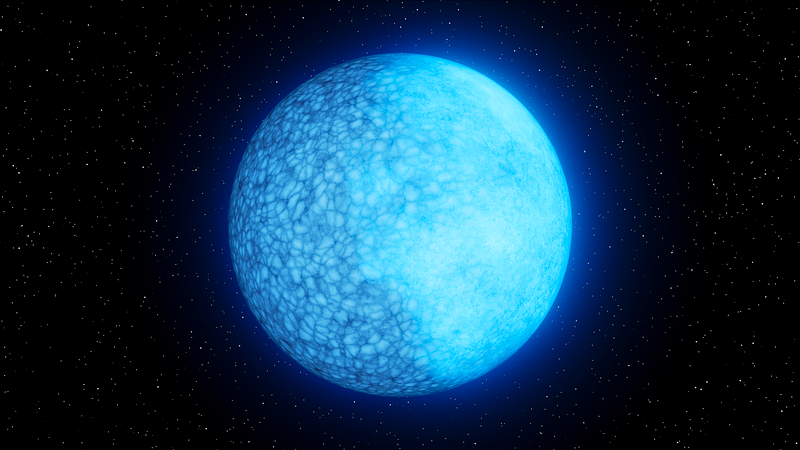The Cosmic Mystery of Janus: A Two-Faced White Dwarf Star
Written on
Chapter 1: Introduction to Janus
An imaginative representation of Janus, the two-faced white dwarf star, showcases its unique properties.

Why has this extraordinary stellar remnant captured the attention of astronomers? Janus, a peculiar white dwarf, displays a curious composition: hydrogen on one hemisphere and helium on the other.
White dwarfs are incredibly dense stellar entities, typically comparable in size to Earth but possessing mass similar to that of the Sun. This remarkable density arises from the collapse of the core under gravitational forces. Although primarily made up of carbon and oxygen, white dwarfs lack the internal pressure necessary for nuclear fusion—the process that fueled them in their earlier life stages. These stellar remnants are stable, often persisting for billions of years while gradually cooling.
During routine observations of the night sky aimed at identifying remnants of dying stars via the Zwicky Transient Facility (ZTF)—a tool that scans the cosmos nightly from Caltech’s Palomar Observatory—astronomers encountered a fascinating cosmic signal. Further examination revealed a white dwarf over 1,000 light-years away, rotating every 15 minutes and exhibiting an unusual feature.
The star’s surface appeared spherical, yet it displayed two different elements on opposing sides, reminiscent of a basketball cut in half. Hydrogen was detected on one side, while helium was predominant on the other. Although the distribution wasn’t exactly equal, the observable division intrigued researchers, prompting them to explore its unique characteristics.
Section 1.1: Discovery and Initial Reactions
“This was a completely serendipitous discovery. I was completely blown away by what I saw, and so is any astronomer to whom I show the data.”
~ Ilaria Caiazzo, Lead Researcher
The research team affectionately named this enigmatic star “Janus,” inspired by the two-faced Roman deity associated with transitions. The object also carries a technical designation: ZTF J203349.8+322901.1. To thoroughly investigate the star, scientists employed a variety of advanced instruments, including spectrometers and facilities like the Zwicky Transient Facility.
Stellar Corpses: White Dwarfs, Novae, Neutron Stars, and Pulsars - This video delves into the world of stellar remnants, exploring their formation and characteristics.
Section 1.2: Understanding White Dwarfs
Both hydrogen and helium are typical elements found in white dwarfs, which are believed to undergo evolutionary processes where heavier elements settle toward the core and lighter ones rise to the surface. Despite extensive theories surrounding this transitional phase, concrete physical evidence had been elusive until now. The team’s remarkable discovery marks the first observation of such a clear and distinct separation of elements in a white dwarf.
Subsection 1.2.1: Theories Behind Janus
To unravel the mystery of Janus, researchers proposed several hypotheses, each containing two critical aspects. Initially, they considered that Janus might have been captured during the convection process, a time when elements began to intermingle.

Asymmetric magnetic fields could have influenced the distribution of materials within the white dwarf, leading to their uneven dispersion. This phenomenon is observed in certain white dwarfs when they reach a specific temperature, similar to Janus' current state. Additionally, researchers proposed that Janus may have asymmetrical magnetic fields, which could be pivotal in explaining its peculiar features.
This suggests that one hemisphere of the white dwarf might possess stronger magnetic fields than the other. Moreover, these fields could significantly affect the abundance of helium and hydrogen on Janus’ surface. The team speculates that these magnetic fields might create lower gas pressures in Janus' atmosphere, resulting in the formation of a hydrogen “ocean” where the fields are stronger.
Chapter 2: Future Implications
Researchers are optimistic about identifying more stars resembling Janus through upcoming ZTF surveys. By gathering a sufficient number of these dual-element stellar remnants, a potential pattern may emerge. Looking ahead, Janus could greatly enhance our understanding of atmospheric physics on a broader scale, as its stability over time challenges existing notions of white dwarf atmospheres.
Astronomers Are SHOCKED After A MASSIVE Explosion Shakes The Universe | FIRST Ever Hyperburst - This video discusses cosmic phenomena that could alter our understanding of the universe.
In conclusion, the complete findings of this research have been published in the Journal of Nature. Stay informed with the latest developments in cosmic studies.